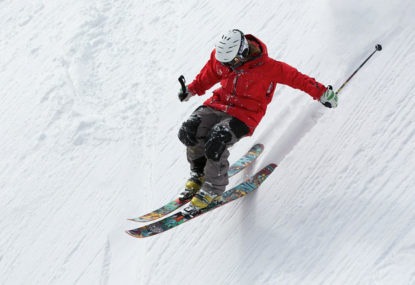'An iconic roster': LeBron, Steph, KD headline all-star cast for Team USA's shot at Olympic glory
LeBron James is going back to the Olympics for the first time in 12 years. Steph Curry is headed to the games for the…

The first athletes to really notice the impact of climate change were those engaged in winter sports.
Turin 2006, Vancouver 2010 and Sochi 2014 had to rely on snowmaking equipment rather than natural snow, which is predicted to be the case for all future Winter Olympic Games.
Even the Iditarod classic Alaskan dogsled race required snow to be trucked in this year. When a race being held close to the Arctic Circle needs trucked-in snow during winter, you know there is a major problem.
In Australia, the increased rain and warmer winters may make snow sports impossible in the near future, even with snowmaking equipment.
Many countries already have indoor snow and ski centres (even Dubai) and Sydney potentially has one on the way. It could only be a matter of time until winter sports mainly take place indoors.
In sport performances, there are two factors which need to be addressed – the welfare of the players and the comfort of spectators. For sports that are played in the summer months, there is a growing understanding of the threat of heat to players and correspondingly sports have developed heat policies to deal with this.
Climate modelling tells us that summer temperatures will continue to rise and that there will be more days with heat extremes. Even on a local scale heat is having an effect, for example, during the summer months classes and games are starting earlier or later, and are having additional drinks breaks.
Most Australians enjoy sport and understand its importance for health and wellbeing, so we are not about to abandon it. But in the future we can expect sport played in temperatures above 40° or in driving rain on waterlogged pitches, which is dangerous for the players and uncomfortable for spectators.
As climate change is now essentially unstoppable, we cannot change the unpredictable extremes of weather. Instead, we will have to change something else. Some of the options are:
After the prolonged drought at the start of this millennium, many state and local governments began investing in synthetic turf pitches. The drought had made it difficult and expensive to maintain natural grass surfaces, and replacing them with artificial pitches was considered a good investment.
However, these surfaces – while saving on water, pesticides, mowing etc. – have their own problems, including retaining and reflecting so much heat that they can both cause injury to players and exacerbate climate impacts. This hasn’t stopped their rapid advance in use in Australia, with a with a plan to build eight more in South Australia announced only last week.
The simplest solution to mitigate against heat and storms is to take all sports indoors.
Already basketball, netball, combat sports, pool swimming, gymnastics and the fitness industry take place in indoor environments. But still the most popular sports, such as golf, athletics, all football codes and snow sports, overwhelmingly take place outdoors – and this is because generally people like to play sport in the open air.
To cater to this outdoor demand (which will continue to grow) requires more courses, ranges, tracks and playing fields. There are also other options to get the best of both worlds – such as Parap pool in Darwin, which has built a full canopy over an outdoor pool.
There are many local solutions that work, but without national leadership and guidance, sporting organisations as well as local and state governments will continue to build facilities that are not sustainable.
One route to ensure that money is not spent on building potentially redundant new sporting facilities is to require that any proposed facility conforms to a defined set of criteria that take into account our future climate. In this way, we can improve the long-term sustainability of our infrastructure and sport.
Australian sport is already seeking to adapt and fight climate change through bodies such as the Sport Environment Alliance and AFL Green Clubs.
The Western Australian and other governments have recognised this as an issue. However, it is possibly time that the issue was addressed on a national level with greater centralised support and coordination. We won’t be the first nation doing this, as in the US the Green Sports Alliance has been leading the way, and in the UK, London 2012 showed that is it possible to create sustainable games and build sustainable venues.
The time when climate change could be avoided has now passed, and so while we must continue to find ways to prevent it getting worse, we also need to adapt.